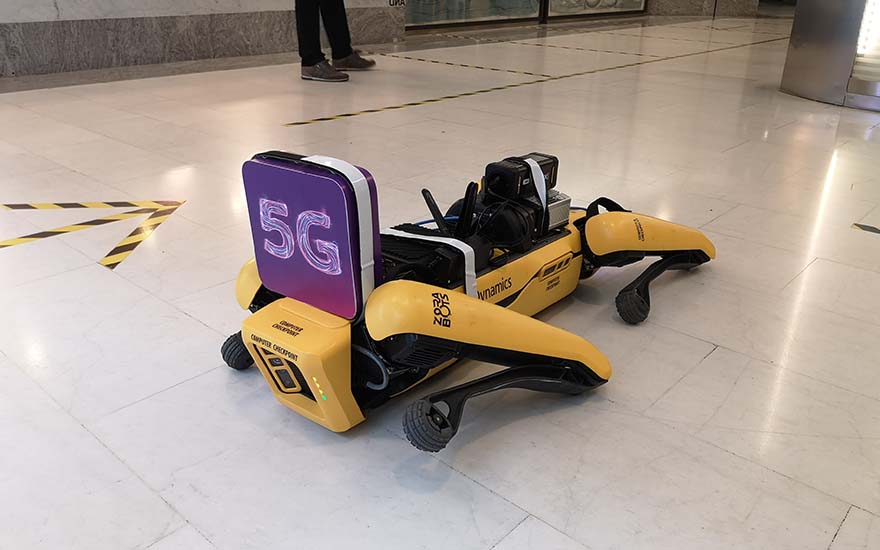Faithful four-legged friend accelerates innovation
Published on 07/04/2022 in Innovate
For a wheeled robot, a small step up is often an insurmountable threshold. But not for robot dog Spot. Combined with 5G, this opens the door to a completely new approach to support and automation.

“Over the past few years, we’ve seen a huge increase in the demand for robotic services,” says Edy van Acker, CEO of Computer Checkpoint. The company has worked with computing and multimedia for over thirty years but has also been offering humanoid robots for several years. These devices best lend themselves to interactive, intelligent tasks, such as reception and assistance. “During the Covid pandemic, one of the things companies asked were robots that could measure the temperature of visitors.”
Computer Checkpoint is the first company in Belgium to add Spot from the American robot developer Boston Dynamics to its product range. Spot is a robot dog. It does not roll along the ground on wheels - as most standard models do - but walks on four legs, just like a dog. “That offers a huge advantage,” Edy explains. “Spot can be used on just about any terrain: on uneven ground, on grass, and so on. The robot steps over thresholds and can climb stairs.”
Spot can take images and measurements from a safe distance in locations that are inaccessible to humans or just way too dangerous.
Edy van Acker, CEO of Computer Checkpoint
Hazardous situations and unmanned sites
Spot’s deployment offers a lot of new possibilities because Spot can be equipped with cameras and measuring equipment that it can control remotely. “This allows you to take images and measurements from a safe distance in locations that are inaccessible to humans or just way too dangerous,” says Edy. “When there is a risk of a gas leak, for example, Spot can check on site whether there is a risk of explosion. Or the fire department can send Spot ahead to explore a dangerous situation.” Equally, the robot dog can monitor unmanned sites.
Using Spot as part of an automated process makes it even more interesting. “Think, for example, of visual inspections of a pipeline at an industrial site,” says David De Meyer, B2B manager at Computer Checkpoint. “You can program Spot to run a daily monitoring round, taking video of pipes and meters. Using AI to analyze those images then allows for immediate detection of an anomaly.” Spot itself also uses AI. “He does that, for example, to avoid obstacles on his route.”
Connectivity via 5G
The example shows how a robot like Spot can be the missing link in the automation of certain processes. Not every industrial plant uses IoT to collect data directly. When Spot takes images or performs measurements at those locations, the necessary data can still be obtained remotely. “This makes 5G the final piece of the story,” says Philippe Soutaer, 5G Innovation Platform Lead at Proximus.
5G provides a uniform, always-on connection at high speed and without delay, wherever you send the robot from a distance.
Philippe Soutaer, 5G Innovation Platform Lead at Proximus
By default, Spot is controlled via any Wi-Fi network that Spot is connected to or broadcasts. This means that either Wi-Fi must be present or the operator controlling Spot must be near the robot. “But on large industrial sites, Wi-Fi is not available everywhere,” Philippe explains.
“That is when 5G can provide a uniform and constant connection to Spot, without latency, so that the robot can transmit images and other data smoothly and in real time.” Computer Checkpoint and Proximus jointly built a setup that connected Spot to 5G and could be controlled over 5G. “It feels like you’re controlling the robot with an old-school remote,” says David, “that’s how fast it goes. That makes connection through 5G a very powerful tool.”
Co-creation thanks to the 5G innovation platform
Computer Checkpoint and Proximus conducted the tests with Spot in the context of the 5G innovation platform. “We are strongly committed to co-creation,” Philippe concludes. “We will continue to scale up the setup together so that we can also do tests with a whole fleet of robot dogs at the same time. There is no end to the opportunities.”
Computer Checkpoint has been working in computer science and multimedia for over thirty years. The company offers its services through stores in Aartselaar, Eeklo, Lokeren, Oostakker, Sint-Denijs-Westrem, and Wetteren.
Edy van Acker is CEO of Computer Checkpoint.
David De Meyer is B2B manager at Computer Checkpoint.
Philippe Soutaer is 5G Innovation Platform Lead at Proximus.
A 5G Private Network is a closed network built specifically to meet the needs of a particular organisation. It offers higher bandwidth, lower latency and more security than public networks, resulting in better performance, reliability and efficiency. This makes it ideal for companies looking to implement advanced applications such as augmented reality, industrial automation and autonomous vehicles.
One
One magazine is the Proximus B2B magazine for CIOs and IT professionals in large and medium-sized organisations.